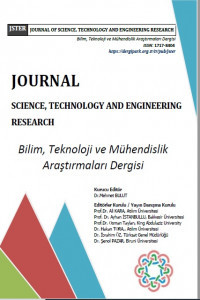Contemplation of the Photonics Beam to Complement the Water Cycle in Gulf Region
elevated duct, refractive profiles, propagation factor, fading, loss
Contemplation of the Photonics Beam to Complement the Water Cycle in Gulf Region
elevated duct, refractive profiles, propagation factor, fading, loss,
___
- [1] I. E. Elmutasim and I. I. Mohd, “Examination rain and fog attenuation for path loss prediction in millimeter wave range,” in Lecture Notes in Electrical Engineering, 2021, vol. 666, pp. 935–946, doi: 10.1007/978-981-15-5281-6_67.
- [2] L. Sfîcă, M. Bulai, V. A. Amihăesei, C. Ion, and M. Ștefan, “Weather conditions (With focus on uv radiation) associated with covid-19 outbreak and worldwide climate-based prediction for future prevention,” Aerosol and Air Quality Research, vol. 20, no. 9, pp. 1862–1873, 2020, doi: 10.4209/aaqr.2020.05.0206.
- [3] S. Pan and Y. Zhang, “Microwave Photonic Radars,” Journal of Lightwave Technology, vol. 38, no. 19, pp. 5450–5484, 2020, doi: 10.1109/JLT.2020.2993166.
- [4] I. E. Elmutasim and I. I. Mohd, “Investigate the Electromagnetic Waves to Desalinate Gulf Water and beyond,” in 2020 7th International Conference on Frontiers of Industrial Engineering, ICFIE 2020, 2020, pp. 119–122, doi: 10.1109/ICFIE50845.2020.9266726.
- [5] K. A. K. Charfeddine Lanouar, Afnan Yousef Al-Malk, “Air Pollution in Qatar: Causes and Challenges,” White Paper, vol. 1, no. 3, pp. 1–7, 2016.
- [6] D. R. Roshan, M. Koc, A. Abdallah, L. Martin-Pomares, R. Isaifan, and C. Fountoukis, “UV index forecasting under the influence of desert dust: Evaluation against surface and satellite-retrieved data,” Atmosphere, vol. 11, no. 1, 2020, doi: 10.3390/ATMOS11010096.
- [7] P. A. Lightsey “Scintillation in ground-to-space and retroreflected laser beams,” vol. 33. no. 8, pp. 2535–2543, 1994.
- [8] K. E. Wilson and J. R. Lesh, “An overview of galileo optical experiment (GOPEX).” Tech Report: TDA progress Report 42-114, Communication Systems Research Section, NASA, 1993.
- [9] K. E. W. M. Jeganathan, “Preliminary analysis of fluctuations in the received uplink-beacon-power data obtained from the GOLD experiments.” [Online]. Available: https://www.toptechnoynews.com/. [Accessed: 21-Mar-2021].
- [10] H. Kaushal and G. Kaddoum, “Optical Communication in Space: Challenges and Mitigation Techniques,” IEEE Communications Surveys and Tutorials, vol. 19, no. 1, pp. 57–96, 2017, doi: 10.1109/COMST.2016.2603518.
- [11] D. B. A. Biswas, “Mars laser communication demonstration: What it would have been.” [Online]. Available: https://www.toptechnoynews.com/?camp=AACV&ron=&no=1&c=1. [Accessed: 21-Mar-2021].
- [12] G. Wang et al., “Highly efficient optical beam steering using an in-fiber diffraction grating for full duplex indoor optical wireless communication,” Journal of Lightwave Technology, vol. 36, no. 19, pp. 4618–4625, 2018, doi: 10.1109/JLT.2018.2832200.
- [13] X. Sun et al., “Field Demonstrations of Wide-Beam Optical Communications through Water-Air Interface,” IEEE Access, vol. 8, pp. 160480–160489, 2020, doi: 10.1109/ACCESS.2020.3020878.
- [14] A. Garufo et al., “Pulsed Photoconductive Connected Slot Array Operating at the Sub-mm Wavelength Band,” EuMIC 2019 - 2019 14th European Microwave Integrated Circuits Conference, pp. 266–269, 2019, doi: 10.23919/EuMIC.2019.8909489.
- [15] W. Tang, S. Yueh, D. Yang, A. Fore, and A. Hayashi, “Investigating the utility and limitation of SMAP sea surface salinity in monitoring the arctic freshwater system,” International Geoscience and Remote Sensing Symposium (IGARSS), vol. 2018-July, pp. 5647–5650, 2018, doi: 10.1109/IGARSS.2018.8519602.
- [16] E. A. Velichko, “Resonance scattering and absorption of light by a silver tube of large diameter and nanoscale thickness,” 2017 IEEE International Young Scientists Forum on Applied Physics and Engineering, YSF 2017, vol. 2017-January, pp. 104–107, 2017, doi: 10.1109/YSF.2017.8126599.
- [17] A. Semenova and A. Tikhomirov, “Feedforward carrier estimation method for bpsk with large Doppler shift,” BIHTEL 2014 - 10th International Symposium on Telecommunications, Proceedings, 2014, doi: 10.1109/BIHTEL.2014.6987643.
- [18] W. Li, Y. Liang, and M. Fu, “The radio propagation affected by variation of refractive index,” Proceedings - 2009 3rd IEEE International Symposium on Microwave, Antenna, Propagation and EMC Technologies for Wireless Communications, MAPE 2009, pp. 560–563, 2009, doi: 10.1109/MAPE.2009.5355602.
- [19] M. Zahn, “Derivation of the korteweg-helmholtz electric and magnetic force densities including electrostriction and magnetostriction from the quasistatic poynting’s theorems,” Annual Report - Conference on Electrical Insulation and Dielectric Phenomena, CEIDP, pp. 186–189, 2006, doi: 10.1109/CEIDP.2006.312092.
- [20] M. Raya-Armenta, E. Alvarado-Mendez, and J. F. Gomez-Aguilar, “Dynamics of a charged particle in a ramp magnetic field,” Conference Proceedings - 12th International Conference on Laser and Fiber-Optical Networks Modeling, LFNM 2013, pp. 95–96, 2013, doi: 10.1109/LFNM.2013.6644848.
- Başlangıç: 2020
- Yayıncı: Mehmet BULUT
Dense Evrişimsel Ağ Kullanarak Kan Hücresi Görüntülerinden Kan Hücrelerinin Sınıflandırılması
Windows Gömülü Bilgisayar üzerinde Petrol Sondaj Kulesi için Endüstriyel İletişim Güvenirliliği
Ongun YUCESAN, Altan ÖZKİL, Efe ÖZBEK
Covid-19 Virüsü Salgını İle Mücadelede Büyük Veri Çalışmaları: Çin Örneği
Berna VATANSEVER, Hakan AYDIN, Ali ÇETİNKAYA
Endüstriyel Robot Hareket Planlama Algoritmaları Performans Karşılaştırması
Değişken Önemini Değerlendirmeye Dayalı Makine Öğrenme Algoritmalarının Karşılaştırmalı Analizi
Contemplation of the Photonics Beam to Complement the Water Cycle in Gulf Region
Imadeldin ELMUTASİM, Izzeldin I. MOHD, Khalid Hamid BİLAL
Öz yinelemeli sinirsel ağların sinirsel atım verilerinden yararlanılarak modellenmesi hakkında
